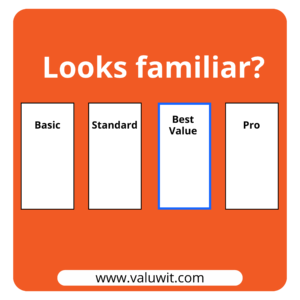Top 8 Pricing Strategies for Your Services and Products
Customers, whether you’re a business-to-business (B2B) or business-to-consumer (B2C) company, care about the price versus the value of an offering.
While price isn’t the only factor to impact decision-making, it’s certainly one of the most important factors buyers consider. Research publication Demand Gen’s B2B Buyer’s Survey: Economic Uncertainties Renew Buyer’s Focus on Price & Functionality showed that 79% of buyers prioritize price, while only 76% consider features and functionality.
The report highlighted three key elements that influence business decision-making.
- Easy access to pricing and competitive information
- Relevant content that speaks directly to key audience
- Communication that demonstrates industry expertise
It’s worth noting that some pricing strategies work for some industries, while others don’t. B2C companies like Pepsi, Nike, Netflix, and others use different pricing strategies compared to mega B2B players.
When pricing a new product or service, there are several factors to consider, such as the type of business, the offering, the size of your target market, and their expectations to name a few.
Top Pricing Strategies for Services and Software
These are the most common pricing strategies for software-as-a-service (SaaS) and service companies.
1- Competition-Based Pricing
As the name suggests, competition-based pricing is based on benchmarking with your competitors, their offerings, and their pricing.
This pricing strategy is quite common among B2C and direct-to-consumer (D2C) companies.
Two examples of companies using competitive pricing are Amazon and Walmart. Both retailers are constantly changing–or adjusting–the prices of various products. That said, Amazon and Walmart use a combination of competitive and dynamic pricing strategies to generate more sales.
The major downsides of competitor-based pricing are its lack of sustainability and how it eats away at a business’ bottom line
2- Cost-Plus Pricing
Also known as the markup pricing method, cost-plus pricing involves adding a fixed percentage, or markup, to the cost of producing a product.
For example, if it costs $2 to make a cup of coffee and the brand wants to make a 50% profit, then they’d sell each cup for $3. This would include each unit’s share of the rent, baristas, electricity, and all incurred costs.
3- Price Penetration
As its name suggests, the price penetration strategy is about getting your product in front of a wide audience. You enter the market with a low starting price to get the largest number of customers. This method is sometimes referred to as market penetration pricing.
Unlike cost-plus pricing, which doesn’t take the customer buying trends into consideration, price penetration has a different goal. It’s often used with price-sensitive customers and in saturated markets.
With price penetration, businesses seek to increase their revenues and profits by boosting sales, despite the lower profit margin.
One of the top disadvantages of this pricing strategy is it may cause consumers to expect low prices all the time. A brand may end up with sales from bargain seekers, and acquiring customers only because they are the cheapest in the market.
4- Price Skimming
The price skimming strategy involves launching new products at a high price and gradually reducing that price over time. Typically, the company reduces prices as competition increases. However, if it prices its services too high, it risks being able to sell its products to customers to begin with.
Athletic wear retailer Nike uses the price skimming strategy for its products. Price skimming isn’t common among service-based businesses like consulting firms or SaaS.
This method is considered the opposite of the price penetration) strategy.
5- Value-based pricing Pricing
Also known as consumer-based pricing, the value-based pricing strategy is about uncovering your customers’ willingness to buy your products.
As its name suggests, consumer-based pricing focuses on the consumer, their expectations, and the value they’re getting.
Companies using this pricing method have an opportunity to listen to customer feedback, improve their products, and increase customer retention and loyalty.
One of the most popular companies using value-based pricing is Starbucks. They combine research with customer analysis to set their target price for new products and price maximization for price increases.
The biggest downside with the consumer-based pricing strategy is the amount of time needed and research involved.
6- Dynamic Pricing
Also known as flexible pricing, the dynamic pricing strategy relies on companies adjusting the prices of their products and services based on demand.
When demand is high, they increase their prices; when it’s low, their prices drop.
Amazon and Walmart use a combination of dynamic pricing and competitive pricing. Their dynamic pricing relies on algorithms and data of how many people add a product to their wish list or cart, and frequent purchases, among other variables.
Similarly, AC, heating, and ventilation maintenance-offering companies increase the maintenance service fees in seasons when demand is high.
7- Tiered Pricing
The tier-based pricing method is the most common among tech businesses. It works well because it accommodates different customers and needs.
Companies using the tiered pricing method offer 3 to 4 tiers or levels. Each tier has several features and benefits.
A major advantage of this method is how it allows companies to cater to different target audiences, whether individuals, small startups, or large corporations.
It offers customers the freedom of choice and upgrading when needed, in addition to discounts on annual subscriptions.
8- Freemium Pricing
This is more of a pricing tier, usually associated with the tiered pricing method. However, it’s one of the most common approaches in SaaS businesses.
Freemium pricing involves offering a basic tier or set of services free of charge. The purpose here is to give a taste of the software or service for free, where many users will opt to upgrade to a paid tier to enjoy the rest of the features.
Design platform Canva is one of the most popular SaaS businesses using the freemium pricing method. Email marketing giant, Mailchimp is another example.
Pricing Pitfalls to Avoid
Before you choose which pricing strategy to use for your service-based or tech business, there are pricing pitfalls to avoid.
One-Price-Fits-All
The biggest mistake you can make with your service pricing strategy is to assume one price suits all your audiences. That’s why most SaaS businesses use a tier-based pricing strategy. Each tier has some features or perks and serves different types of customers.
Being Vague About Pricing
Another mistake companies make, especially when they’re just starting out is not being clear about how their pricing is calculated.
They keep their pricing under wraps in the hopes of giving a different price for each customer. Not only does this make the sales process unnecessarily long, but it also overuses the company’s resources. While companies may claim that this is some form of tailored pricing, it may result in unfair pricing for different customers.
Pricing Too High or Too Low
Companies will often price their products or services too low to beat the competition, going too far in terms of a penetration-pricing strategy.
Pricing your products too low means a squeezed profit margin, especially as costs increase.
If you’re a B2C or D2C business, offering the lowest price amongst your competitors may give you an initial bump. But it’s not easy to sustain this low price. Something will have to give. Often it’s quality, which means you’ll lose customers down the line.
On the other hand, offering too high a price may get customers to shy away from your product. If you’re not offering stellar perks or features to go with that sky-high pricing, customers will look the other way.
Not Studying Your Competitors
Businesses will often look at what their competitors are charging and try to offer a slightly lower price. However, it’s important to take a closer look at the competition.
- How long has this competitor been in the market?
- What pricing strategy or strategies are they using?
- Did they change their pricing strategy in the past year or even decade?
- How do customers perceive their products?
- What are customers’ top problems with the competitors’ products or services?
Answering these questions helps you create a better pricing strategy and identify areas where you can stand out from the competition.
The bottom line, pricing isn’t always a straightforward process. Understanding fundamental pricing strategies is only the first step. Consider testing different approaches, and understanding the individual needs of your niche and your company’s potential.
Ultimately, your goal isn’t only growth in numbers, it’s both customer acquisition and retention.





